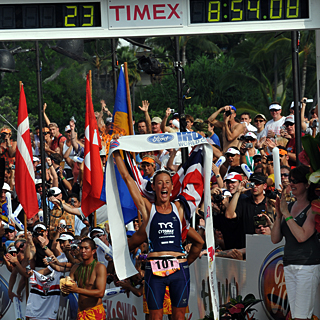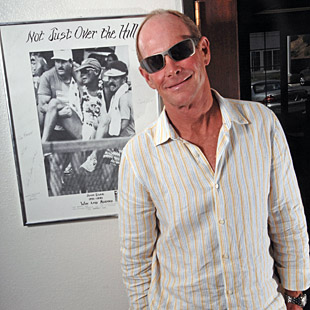A Q&A with Paula Newby-Fraser
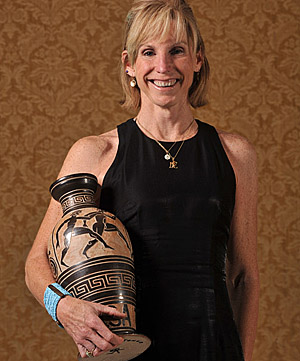
As Bob Babbitt put it so well, Paula Newby-Fraser changed the perception of what a female endurance athlete could accomplish. The 23-year-old from South Africa was the first woman to go under 10 hours with her 9:49:14 winning time at Kona in 1986. She shocked the world of endurance sport when she took 11th overall including the men and smashed the course record by 34 minutes when she won with an amazing 9:01:01 time in 1988. In 1992, she won her 5th Ironman Hawaii with a course record time of 8:55:28 — a record which stood for 17 years until Chrissie Wellington broke it this October. After a spectacular collapse in the final mile at Kona in 1995, Newby-Fraser came back in 1996 with her smartest race ever to win an unmatched 8th Kona title – two more than Dave Scott, Mark Allen and Natascha Badmann. Her grand total of 24 Ironman victories is nearly twice as many as the 15 wins earned by her closest challenger and good friend Heather Fuhr.
But the happy surprise of Newby-Fraser at age 47 is that she has such a feeling of gratitude and sense of humility about her place in the grand scheme of triathlon – and a profound thankfulness to the pioneer organizers who gave shape to the sport to which she devoted her life.
In Part 1 of a two-part interview, Newby-Fraser recounts the contributions made by fellow inductees Valerie Silk, Jim Curl and Carl Thomas; her early days in the sport; the surprisingly humble beginnings of her second career in race management; and her work today for the World Triathlon Corporation with the charitable Ironman Foundation and helping set up the WTC’s new drug testing program.
Part 2 will cover her rivalry with Erin Baker, her long winning streak, what was behind her shocking collapse in 1995, and her reflections on Chrissie Wellington.
Thoughts on the USAT Hall of Fame
Slowtwitch: What does election to the USAT Hall of Fame mean to you?
Paula: Well I have been inducted into Ironman Hall of Fame and it’s very specific to that genre of racing. So making the Ironman Hall of Fame was a lot more obvious – a no brainer.
Whereas the USAT Hall of Fame seems to me to reflect a much broader stroke of the sport and it encompasses everything that is triathlon. Based on the people inducted so far, it includes people who have greatly influenced the direction of the sport.
When they called me I was extremely surprised. I thought there were so many other people who could be in consideration for it. People I am sure who will ultimately belong.
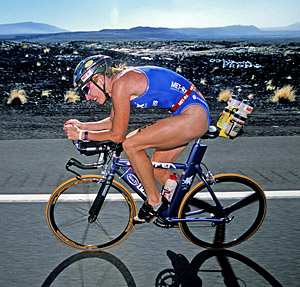
ST: What do you think about going in with pioneer race organizers like Ironman’s Valerie Silk and USTS co-founders Jim Curl and Carl Thomas?
Paula: It is great to go in with people I have known from the beginning like Jim and Carl and Valerie. To go into the Hall of Fame with them makes us all look back all the way to the beginning of the sport. They were people who influenced and gave professionals the platform we all needed for our careers.
ST: What part did Valerie play in your career? I saw you shed a few quiet tears when they read Valerie’s kind words about you.
Paula: Valerie Silk always looked so poised and she just had such a gentle spirit about her. At the same she guided and directed something so really big you almost wondered how did she do it? Where was that edge to her? I have an edge to myself and that’s what you expect when you encounter people at the helm of such a big enterprise. But I never felt that edge with her. She was always so kind and had so much compassion for all the athletes.
ST: What did you think about Jim Curl and Carl Thomas?
Paula: A lot of people didn’t realize what it is they did and how great it was until you heard Jim Curl speak tonight. He was funny and spoke from the heart and what he said related to every influential race director in the audience. While Jim was speaking, I glanced over at Graham Fraser (the President of Ironman North America, which was fairly recently sold to the World Triathlon Corporation) who is very passionate about his events and their relationship with communities where they are held. I saw that he was nodding his head. That’s because Jim put into words the emotions Graham had as he developed his first race series in Canada and as he developed Ironman events in North America. The ideas that Jim expressed about running triathlons took the business out of it and got to core values that drove it all. We all did it for similar reasons. I believe that it wasn't money that drove me to do my races — although it was a secondary motivation. It was kind of nice of Jim to strip away all the superficial things.
ST: Carl Thomas was another story – a big picture man who helped found what became the ITU as well as co-creating the USTS. What made him special?
Paula: Carl Thomas had more of a political mind. It took a politician to see how this new sport fit into the greater political landscape of sport. That vision came from his involvement in swimming as a competitor and as an executive with Speedo. Together Jim and Carl were the perfect left brain-right brain mix. You could totally see Carl the chess player who plans three moves ahead of everyonre else. Jim made sure the passion was there and everything was working at ground level.
ST: Was triathlon lucky to have such talented and far seeing pioneers of the sport?
Paula: I agree with you. It is always good to look back and realize how great they were. At the same time, there were some pretty great people along the way who managed to carry on after them. And there are some very visionary people who are part of the sport now. Obviously the landscape has changed tremendously. It becomes politicized and bureaucracies form and growth occurs. The vastness of it all requires a continued excellence. We still have some pretty great new people and we are fortunate they are there. This sport developed out of passion and the people who were there at the get-go had to have that passion. But we were very fortunate to have a few people who were able to take that passion and channel it in constructive ways that allowed it to grow.
The Early Days

ST: How important were the Multisport School of Champions camps ? The personal connection you forged with age groupers seemed to have a Johnny Appleseed effect on the growth of the sport?
Paula: I guess in a way we really started something. The multisport camps were very important in my life. They were very instrumental in making me understand that what I was doing as an athlete was influencing a lot of athletes and inspiring them. Although from my perspective I was learning a lot from the campers themselves and passing on the information I had acquired from competing and from training with some of the greats in our new sport. The things I taught the campers were not drawn from a lot of different sports and mashed together. They were designed to let them know how to put together a program that would prepare them best for this this new exciting sport. I had confidence that what I was passing on to the campers was very raw and very real and effective because I had tried and tested all of those ideas. So we built a tradition of bringing in good athletes and people who knew things about training and racing and putting them in touch with people who were inspired and wanted to get into it. Those camps also instilled the realization that this is a participation sport. And that is what is wonderful about triathlon. No one is elevated above the rest. On a bad day, some of the campers could go riding right by me.
ST: When you came into the sport you soaked up training and racing ideas from a lot of people. It seems as if you have a very analytical mind honed by your schooling in South Africa and that helped you convey those new ideas to your sport. Who influenced you and what was your scientific approach? Did you have a coach?
Paula: That is easy. I never had a coach. I came from South Africa and was very heavily influenced by Dr. Timothy Noakes, a renowned expert in the scientific principles of training. Noakes didn’t assign my training. I started watching the Comrades Marathon in South Africa (a legendary 54-mile point to point road race) and that influenced and inspired me to start running. I knew many of the top runners and Timothy Noakes was very influential with a lot of those runners. He had a very interesting philosophy. I had just started in triathlon and I had a little success. He said ‘Paula always get by with as little training as you possibly can.’ And so I always went with that. Except for 1995.
When I came to the States to become a professional triathlete, really the greatest influences on me were people like Scott Tinley. Just by watching the consistency of what they did. At first I had no consistency. I would wake up any given day and ask whoever was going out for a workout if I could join them. I did whatever I felt like I wanted to do. But really the breakthrough came in 1988.
ST: What happened then to lead you to that amazing 1988 breakthrough when you dropped the Ironman Hawaii course record by 34 minutes and placed 11th overall including the men?
Paula: You must understand when I left my home in South Africa and came over in ‘86 I was successful right away, But in 1987 I had the disappointment of losing Hawaii. It was related to the pressure. Always in the back of my mind I had the idea I would go back to my real life. In 1988, after the disappointment of getting beat in '87, I realized what I lacked was really mental. I led 1987 until almost 23 miles into the marathon, then two people went by me (Erin Baker and Sylviane Puntous). There was no good rhyme or reason why they went by me other than I had no confidence.
Then in 1988 (agent) Murphy Reinschreiber became a part of my life and helped me get some excellent contracts, which gave me some peace of mind and a steady income. But the biggest thing that happened to me in 1988 came about because I made a personal decision that triathlon wasn't just something I’m going to do year-to-year as an interim thing before whatever it is I am really going to do with my life. Instead, I made the commitment in ‘88. I said this is what I am going to do. I went out purchased a heart rate monitor and laid out a training program based on what some other people were doing and what I could glean from experts and the top triathletes.
ST: You didn’t just accept the word of a coach or one authority?
Paula: I asked questions and sifted through the various ideas to decide what worked for me. There was this guy in San Diego by the name of Gary Hooker and he seemed to have the best grasp on successful triathlon training. I also read about Mark Allen’s program, I sifted it through and put some of it on my workouts. Until then I had walked every aid station of the marathon.
ST: At that point, you decided you would approach this sport as a professional?
Paula: I just said 'You know what? From now on I am dedicating myself to professional, scientifically based training. I am also going to approach the public relations side and work for my sponsors in a professional manner.' So I moved from ;'This is what I am doing before what it is I am really going to do,' and threw away my parachute. From that decision came the 30 minutes I took off my time at Ironman Hawaii right there.
ST: Were you thinking about Erin Baker after losing to her in 1987 as you prepared for a rematch in Hawaii?
Paula: I was thinking about her. Absolutely. To a large degree. She influenced my commitment not only to be gracious competitor — because I thought she was tremendously ungracious. But she also influenced my commitment to sticking with my training plan and decided I would not follow hers or anyone else’s. She certainly worked a lot harder and did a lot more training mileage. But I believed in the success I had with the workouts I had formulated for myself. In the beginning, for a couple of years, I went along with whatever workout was happening on the day.
ST: Did you find a compatible workout partner to help with your breakthrough?
Paula Sara Coope (third at IMH in 1991) and I were workout partners. We were very well matched. She stayed in the winter in San Diego and we did what we set out to do. She was a consistent training partner, somebody who was supportive. Right off the bat in 1988, we went to St. Croix. We didn’t win, but I was second and she was third or fourth. People asked us, ‘What have you girls been doing in San Diego?’ My performance jumped by April and it just kept rolling. That was the year I raced the Bud Light USTS series and I ran some running races. I was training myself to be a runner because I had not been a runner to that point. That was a pivotal year. A mental shift for me. Once I made that shift, I pretty much rolled.
Working Girl
ST: How did Graham Fraser give you a start in race management?
Paula: When I was finished racing, Graham gave Roch Frey and Paul Huddle (Newby-Fraser's long term boyfriend, now husband) the opportunity to race direct events here in California. Starting in 2000, they started as volunteers. One thing about Graham is that he truly believes that to become a good race director and deliver a great product to the athletes, you need to understand every part of a triathlon. Which I did when I started to work for Graham.
ST: How did you react to the switch from being Queen of Kona to doing a lot of menial tasks at first?
Paula: When I started my second career, I had been a pro athlete used to coming in and having things done for me. I didn’t understand the nitty gritty that gave me my platform. I just remember Graham saying he needed someone to handle the job of pro athletes’ liaison for Ironman. The number of athletes was starting to grow and so it was karmic payback for me to have a job handling people just like myself. I got to see what they expected and what they were entitled to and what they complained about
On top of that I was required to work at events. When the race was over, I was handed a trash bag and went into the transition area to pick up after athletes and got to see the garbage that people left behind thinking 'OK, they were entitled to walk away from it. I mne ver realized how much bullshit people leave around and how that is not fair that the race organization takes care of it all.
ST: This sounds like a plot line from The Prince and The Pauper or Undercover Boss. Tell about one of the encounters with folks who didn’t know who you were?
Paula: I also worked in registration and people often didn’t recognize me. I got many snarky remarks that I wasn't fast enough. And I got quite a few sarcastic comments about what I was doing. It absolutely exposed me to the whole gamut of it. At the time I was handling pro athletes, I realized where professional athletes fit into the whole scheme of triathlon. I saw that while pros were wonderful and are great athletes, the very key to it all is the age grouper. I started to realize that pros like myself were not at all more important than the age groupers.
ST: What was the big lesson you learned from this humble beginning?
Paula: Graham taught me that the pros are but one part of the event – one dimension – and you soon realize that a triathlon has many dimensions. After a while, I started to understand it and I started to find ways to make it better. When you make it better and improve the experience for all the athletes, you start to love the process of it. You become enamored with the parallel atmospheres, parallel universes of the event that have nothing to do with what happens in the headlines. All you want is to deliver a great experience for everyone and keep people safe, make sure the aid stations are there and the registration process is happening smoothly, the bike racks and winners medals are there, the timing is in place and working well.
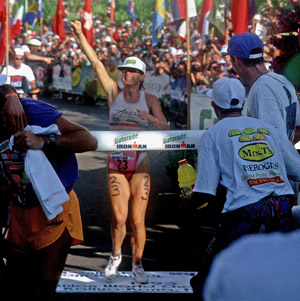
When I started to do a lot of jobs at races, I found at the end of the day I was asking who won the race? I would feel so proud that the race went off well and nobody died, nobody was injured badly, and there were minimal complaints. The sense of gratification of pulling off an Ironman event is great – but equal to and often measured by an exhaustion that is more tiring than doing the race. Then there is a whole other universe of media and sponsors. All those things need to work together but are completely separate.
I worked the registration tent for years at what they call the problem table. I stood there every weekend and was faced with every minute problem. I learned how to handle those problems and change things. Then they put me in the sponsorship area, and I started without knowing anything about race contracts and municipal contracts and sponsorship contracts. At the end, I knew how they worked. Then Graham stepped back and said, 'Take charge,' even though I didn’t know the difference between the two types of barricades.
ST: Graham Fraser didn’t just throw you out there to sink or swim?
Paula: What is great about Graham is that he let me make changes and tweaks. But he always was there. When I came up short and just didn’t know what to do, he would always be there to guide me. It was very flattering to have someone give you that confidence, someone who thinks you’re not just an athlete and that was not all you were. Someone to mentor me and give me an education in a lot of unglamorous work and finally step back and say 'You’re in charge.'
ST: Once you were part of Graham’s organization, I’m guessing you started to mentor some people yourself?
Paula: When (15-time Ironman champion and Newby-Fraser training partner and neighbor) Heather Fuhr started work there, we worked like a seamless team together. She handled the pro athlete liaison work. Then I got excited watching her step up and branch into the VIP thing. It’s been great. Graham started us and then we picked up the jobs.
Without question Graham and the WTC have thrown some pretty monumental tasks at me in the past year and half. I often didn’t even know where to start. But Graham gave me my start and since WTC took over as my boss I have had constant new challenges.
ST: Did Graham help you make the transition in perspective from big contract athlete to a new career?
Paula: That certainly was the other thing Graham taught me — how to earn your money. When I started, I was the lowest paid person in the company. When I began with Ironman North America, he literally made me start at absolute bottom. Now I know what it’s like to earn every penny I make. Interestingly, now I tell Michellie she has to learn to understand what earning money will be like from now on. I said ‘We made a lot and during those times you were given big lump sums of money – but when you break down what it represented per hour of training and working out, it was really very little per hour for all the swimming, biking and running we did. So you might as well realize the value of earning your pay by the hour.'
ST: Are you doing well now?
Paula: I am very grateful to Graham and to Ironman. Graham has been very good to me and Ben Fertic has been very good to me. I appreciate and I think so does Ben appreciate hard work. I worked with him when he was just creating Ironman Live. I watched how hard he worked and I saw him learn and come up and understand the sport and get to the position where he is now leading a worldwide charge.
Paula Today
ST: What are you doing now?
Paula: I work for the World Triathlon Corporation and my job does not have a title or a formal description. My responsibilities are pretty broad and I am sort of a floater. Generally speaking I am a manager of new development and new projects with Ironman. I work with the Ironman Foundation which was something totally new to me — to work to create a cohesive involvement with the communities at all Ironman events. Obviously these events are growing. It takes a lot to put on an event in a community. To be sure we are giving back to communities where we host events. This past year I have been very much involved in the community aspect of a lot of events. We have been establishing capital projects in Coeur d’Alene and Lake Placid and Arizona. My job is to assess the needs of each community and try to find something that will make a lasting positive impact in each place and ensure that we become integral to the community.
The WTC New drug testing program
ST: Ben Fertic has you doing some other important work – helping implement the WTC’s expanded drug testing policy. What is new about it?
Paula: I have been helped by WTC President Ben Fertic, who was a primary mover of and motivator behind setting up Ironman with its own anti-doping entity. He had this vision way back in 2005 to create Ironman’s own set of rules and become a signatory to the WADA code. Through his innovation and implementation, WTC established Ironman as the first and only private organization to run a WADA compliant program worldwide. The impetus came from him – I am the now the one who has to organize the nuts and bolts
ST: What has changed in Ironman drug testing?
Paula: Triathletes – pro and age group – will be tested. Before Ben took the initiative on his own, our national federation and the national anti doping agency chose to really exclude Ironman events from their testing program. We are sanctioned by our federation but support from our own federation or any national or international anti-doping organization has been zero the last few years. The impetus from Ironman has developed from Ben. Other than a few championship races Ironman had previously paid for funding of testing. We were getting zero assistance. That has totally changed with the new program launched in September last year.
Most athletes will say that doping control at Ironman races, prior to races and out of competition testing for Ironman pros and age groupers, is now a fully functioning program. I do not think any athlete can show up at any Ironman race in the world any longer — including places like Lanzarote, Japan, China – and assume they will not be tested.
ST: Who is paying for this?
Paula: The WTC is not being supported in this. The costs are being covered primarily through the new professional membership program. That is what is bearing the brunt of the cost. Ironman itself has previously covered the cost in the USA. At this point in 2010, Ironman has had zero indication that USADA will show up and test. Our program has the support of German anti doping NADA, Australian Drug Free Sport and New Zealand. Once we stepped into the arena, all international agencies serious about anti doping throughout the world have all shown support and cooperation – with the notable exception of USADA.


